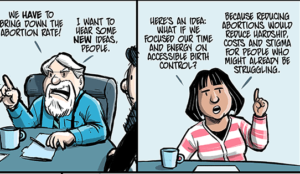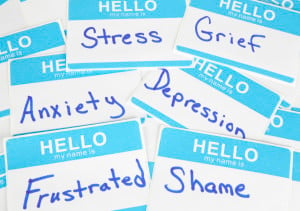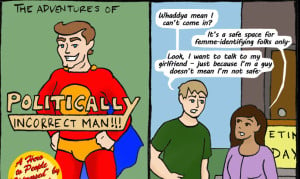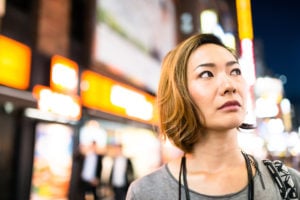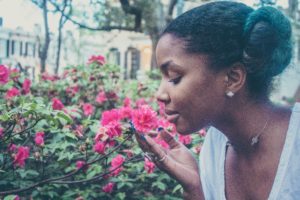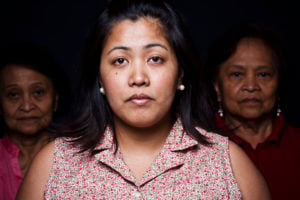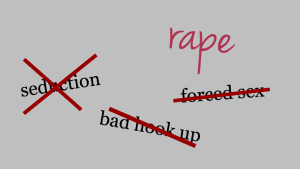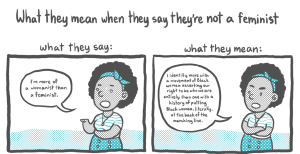
A person sits with a thoughtful expression, one knee drawn to their chest, by a stack of boxes.
My partner and I live together in a mid-sized town in central Virginia.
Here, we only have two friends: my former college roommate and her husband. We always get together on weekends to cook up new recipes, play Settlers of Catan, and watch amazingly terrible Sharknado-esque movies. And then, with the light buzz of beer and wine, something we never fail to do is daydream about the moment we’ll get out of this place – when we’ll move somewhere more exciting, where we’re not always itching to leave.
We’re all in our twenties and came here for graduate school. I just finished my Master’s in Education, and my partner and our friends will soon have degrees as well. The next steps in our lives could carry us just about anywhere.
We’ll start naming cities – LA, Chicago, San Francisco, NYC – the biggest ones with the most charismatic-looking lights and people. But then, it doesn’t take long before I notice that mine and my partner’s list is much shorter than our friends’. You see, my partner and I are both people of color – and our friends are both white.
They’ll start tacking on places like Madison, Wisconsin and Asheville, North Carolina, which I also imagine are beautiful and magical hipster towns that I would probably love to live in. Except for one, unignorable thing: They’re mostly white. And so for me, they’re off the table.
I’ve already spent most of my life being a minority. In the majority-white town I live in now, I often feel isolated. Going for a big night out to a show or wandering into a store, my partner and I will usually be the only people of color in the room.
Even when I was still in grad school, it felt like every other day, a white classmate or professor would carelessly make an offhand racist comment that I couldn’t believe.
Like when my Indian American friend said that she wanted to teach in the inner-city, one of our white classmates snapped back, “Ew, why? Is it because of the minorities?” Another agreed with her, “Oh yes, I also want to teach the blacks.”
But what was worse than the comments, than my professor saying “Take your children to a private school if you don’t want them to be with black kids,” was when I would look around the room at my classmates and see mostly blank, unaffected faces. I felt like the only one who was boiling inside.
And that’s why I decided: never again. The next place I move to will not be overwhelmingly white. I’m tired of being a minority. I know I can’t avoid racism altogether, and that it definitely exists in highly diverse areas too, but at least I could live in a place where I don’t feel so alone.
As for my white friends, they care about diversity, but it doesn’t seem to be as crucial a factor in their major life decisions. And that makes total sense – because wherever they choose to move, there’s a good chance they’ll be comfortably surrounded by people who look like them. And if not—well—they’ll still have their white privilege.
The fact is, people of color face different challenges than white folks in finding acceptable places to live. And while ideally, everyone should be able to live wherever they’d like to, for us, living as a minority can lead to painful everyday experiences.
We’re now living in an age where it’s increasingly common for millennials (acknowledgedly, mostly middle and upper class folks) to move to different cities for education or career opportunities. However, the ways in which systemic racism affects relocators of color is an issue that’s not often talked about.
And understanding these challenges is especially important for white folks who have positions in which they recruit, relocate, or advise people of color on where to move.
For instance, my partner’s medical school advisor (who is white) suggested that he apply to a residency program in Jackson, Mississippi. He said it might be easier for him to get in since so few students apply there. What his advisor didn’t take into account was that my partner is of mixed Filipino and Nicaraguan descent – and the racial demographics of Jackson are 0.4% Asian and 1.6% Hispanic.
If his advisor wanted to research the climate of racism in the area, it would only have taken him two seconds (as it did for me) to find this article in the Jackson Free Press that reads: “The idea is so rampant in this state that it can be called by its proper name, Mississippi Racism. It breathes a different air than other racist places… it’s so normal that it has become expected and accepted all over the state.”
Maybe then, he would’ve advised my partner differently.
But that’s the thing about white privilege: It prevents people from understanding how systems of racial oppression affect people of color and their life opportunities, because they’ve never had to face the same obstacles.
So, to help break down this issue more, here’s a list of things people of color worry about when relocating that white people don’t. And I also want to note that this is coming from my Filipino American, cisgender, middle-class, able-bodied perspective. People of color at other intersections experience these differently, and there’s a whole host of other challenges they face as well.
1. Being a Clearly Visible Minority
Often times, the visual experience alone of being the only person of color in an ocean of white faces is enough to feel othered. Whiteness, as the dominant identity, becomes the standard that you constantly have to measure yourself up against – in beauty, behavior, values – everything.
When I was a kid, I tried my best to live up to that standard, and as a consequence held a lot of internalized disgust towards myself and other Asian people.
But then other times, I forget that I’m different. I can only look out into the world through my own eyes, so the starkness of my skin tone against everyone else’s isn’t always as obvious to me. I don’t feel like “an Asian” walking around, I just feel like myself.
Until the moment someone calls me out on it – What are you? Where are you from?
And then I remember that my difference is inescapable.
As a person of color, living in a place where this is your everyday experience can make you feel disconnected from yourself and others around you.
2. Racism
Being a clearly visible minority leaves you much more vulnerable to racist interactions. This includes everyday microaggressions, which have been shown to take a toll on the physical and mental health of marginalized individuals.
One time, I was walking between classes with a group of students, and five of us just happened to be Asian. A young white professor passed by and belligerently called out to one of the girls walking ahead: “You need to diversify your friends!”
She, being one of his students, laughed back and pointed back to a couple other white students walking with us: “No, look! I have white friends too, see?”
He was trying to be funny. But to me, his joke felt hostile, especially coming from a person of authority.
He was insinuating that a small handful of Asian American students walking together in a majority-white school was something wrong, something that needed be corrected. He looked at us and saw only one thing: Asians who weren’t following the white rules.
I switched out of the program. There were other important reasons, too, but the fact that I felt so uncomfortable just being there as a student of color definitely made leaving easier. If I do ever go back to school, the racial diversity of the student body and faculty will be one of the first things I make sure to check before making any commitments.
3. Safety
Racism can become violent. Racism can destroy and end lives, especially for black and LGBTQIA+ folks. We know this all too well.
Black Americans are killed at twelve times the rate of all people in other developed countries. According to the National Coalition of Anti-Violence Programs (NCVAP), hate-based violence against the LGBTQIA+ community is on the rise, and people of color are twice as likely as white people to experience physical violence.
As people of color, our bodies can be in danger just for existing as we are. So when deciding on a place to live, we have to weigh our options. Is this a city where people who look like us are regularly assaulted or even killed? And if it is, is moving there worth risking our physical safety?
4. Fair Job Opportunities
There have been tons of studies demonstrating how severely racial bias affects people of color’s chances of getting hired.
In this one study, researchers sent out thousands of resumes that were exactly identical except for their names – some of them were stereotypically white, while the rest were stereotypically black. Turns out, resumes with white names were 50% more likely to get called back.
So that’s just a matter of getting the job. But once you have it, then there’s the possibility of being held back from rising up the ladder.
There’s the “concrete ceiling” for women of color, the “bamboo ceiling” for Asian Americans, and I’m sure there are other cleverly named metaphorical ceilings out there as well. Basically, the assumption is that if you’re a person of color, you’re probably just not leadership material.
And then, say you do get hired and promoted: Will you be the only person of color among the higher ranks? Will you have to be the “diversity token” that has to represent all people of color for the entire company or organization?
Anis Gisele explains this well in her article about diversity in the workplace: “Being the minority is lonely – it impresses upon us in every way that our institutions were not built for people like us to take up space.”
5. Finding a Supportive Community
Sometimes you just want to be around people who understand you – whose life experiences resonate with yours, who are excited and repulsed by the same things as you are. Racial and ethnic identity has a lot to do with those kind of connections.
Where I’ve currently lived for the last three years, I have not been able to find that sense of community.
Also, I do want to have kids someday. And as much as it’s in my power, I’ll want to make sure that they’ll be growing up in a diverse community that supports them, and exposes them to a vast array of identities, and cultures, and beliefs. I don’t want their entire childhoods to be consumed by comparing themselves just to whiteness like mine was.
6. Access to Culture
Here where I live, there are no Filipino restaurants. And if I want to cook Filipino food at home, it’s pretty challenging because a lot of traditional Filipino ingredients can’t be found in the local grocery stores. And my relationship with Filipino food goes far beyond love – it’s a part of who I am.
Cultural food, festivals, traditions, and even household objects are all things that reinforce our identities. And the lack of them can profoundly affect one’s feelings of psychological well-being and overall life satisfaction, particularly for folks with strong ethnic identities (which does include white people).
Like when I first moved here and my parents came to visit, they desperately wanted a tabo, a small plastic bucket many Filipinos use to clean themselves after doing their business instead of toilet paper. We drove to the closest Target and my dad asked one of the employees if they sold any, trying his best to describe the object to this guy’s politely confused face. They didn’t, of course.
For all you frequent American toilet paper-users (myself included), imagine if you didn’t have any access to any where you lived and had to drive hours to the nearest store just to get some. Talk about annoying and stressful. Sure, you could use paper towels or something, but it’s just not the same.
When finding a new place to live, having access to the cultural things that you’re used to and remind you of who you are can boost your sense of belonging and happiness. If you live somewhere that doesn’t have those things, you might not feel the same.
7. Marginalizing Other People of Color Through Gentrification
So, white folks should definitely be concerned about gentrification, too. But as a person of color who advocates for social justice for all, I’d feel especially disturbed about marginalizing other people of color in such a profoundly destructive way.
As a middle-class Asian American, gentrifying would also position me as a “model minority,” the myth that Asians are the good minorities who don’t cause trouble. It’s a myth that’s been used to divide POC and serve as a tool of anti-black racism. And that’s just unacceptable.
This makes the task of finding a place to live, especially in a big, cosmopolitan city, all the more difficult. “Up-and-coming” neighborhoods are essentially designed to push out low-income communities of color in order to attract young, middle-class consumers like me.
And while there may be ways to reduce the negative impact of gentrification, there’s not a straightforward answer of how to avoid gentrifying altogether when your class privilege is part of the system that perpetuates it. In truth, this could be one of the biggest ethical challenges of socially conscious people of color who have the means to relocate.
***
When I know what I want, I charge at it full force. Right now, I’ve been working steadily and hard to seize some dream opportunity that will launch my career to the next level.
And as I’ve been scouring the web for jobs, internships, and fellowships, I have found incredible ones that I could see myself thriving in and fulfilling my creative ambitions – but can’t get over the fact that they’re in places that are just too white. And so I don’t even apply.
Does that mean I’m limiting myself? Yes. Yes, I am. But those are the trade-offs I’ve chosen to make, because for a person of color like me, all opportunities are not equal.
To put it this way, I once heard a classmate say that she lived “in a city that always made her feel like the best version of herself.”
That’s what I want.
And to make that a reality, I have to move to a place where I feel like I can belong.
[do_widget id=’text-101′]
Sherina Ong is Writing Fellow for Everyday Feminism and a Filipina American writer, journalist, and intersectional feminist who believes that stories speak louder than words. Sherina juggles freelance writing, radio producing and trying to get people to care about minorities throughNextDayBetter, a storytelling platform for Filipino and Asian Pacific Islander diaspora communities. You can follow her on Medium and Twitter @sherinaong.
Search our 3000+ articles!
Read our articles about:
Our online racial justice training
Used by hundreds of universities, non-profits, and businesses.
Click to learn more






